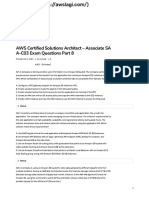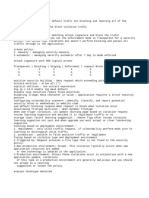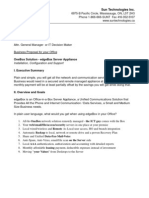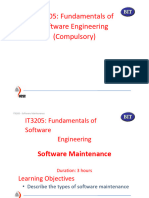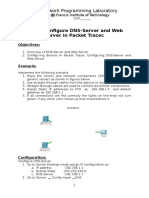www.examtopics.
com /exams/amazon/aws-certified-solutions-architect-professional-sap-c02/view/1/
Unknown Title
Topic 1 - Exam A
Question #1 Topic 1
A company needs to architect a hybrid DNS solution. This solution will use an Amazon Route 53 private
hosted zone for the domain cloud.example.com for the resources stored within VPCs.
The company has the following DNS resolution requirements:
On-premises systems should be able to resolve and connect to cloud.example.com.
All VPCs should be able to resolve cloud.example.com.
There is already an AWS Direct Connect connection between the on-premises corporate network and
AWS Transit Gateway.
Which architecture should the company use to meet these requirements with the HIGHEST
performance?
A. Associate the private hosted zone to all the VPCs. Create a Route 53 inbound resolver in the
shared services VPC. Attach all VPCs to the transit gateway and create forwarding rules in the on-
premises DNS server for cloud.example.com that point to the inbound resolver. Most Voted
B. Associate the private hosted zone to all the VPCs. Deploy an Amazon EC2 conditional forwarder
in the shared services VPC. Attach all VPCs to the transit gateway and create forwarding rules in
the on-premises DNS server for cloud.example.com that point to the conditional forwarder.
C. Associate the private hosted zone to the shared services VPCreate a Route 53 outbound
resolver in the shared services VPAttach all VPCs to the transit gateway and create forwarding
rules in the on-premises DNS server for cloud.example.com that point to the outbound resolver.
D. Associate the private hosted zone to the shared services VPC. Create a Route 53 inbound
resolver in the shared services VPC. Attach the shared services VPC to the transit gateway and
create forwarding rules in the on-premises DNS server for cloud.example.com that point to the
inbound resolver.
Reveal Solution Hide Solution Discussion 97
Correct Answer: A 🗳️
Community vote distribution
A (79%)
D (21%)
B (20%)
Other
1/10
�Question #2 Topic 1
A company is providing weather data over a REST-based API to several customers. The API is hosted by
Amazon API Gateway and is integrated with different AWS Lambda functions for each API operation. The
company uses Amazon Route 53 for DNS and has created a resource record of weather.example.com.
The company stores data for the API in Amazon DynamoDB tables. The company needs a solution that
will give the API the ability to fail over to a different AWS Region.
Which solution will meet these requirements?
A. Deploy a new set of Lambda functions in a new Region. Update the API Gateway API to use an
edge-optimized API endpoint with Lambda functions from both Regions as targets. Convert the
DynamoDB tables to global tables.
B. Deploy a new API Gateway API and Lambda functions in another Region. Change the Route 53
DNS record to a multivalue answer. Add both API Gateway APIs to the answer. Enable target
health monitoring. Convert the DynamoDB tables to global tables.
C. Deploy a new API Gateway API and Lambda functions in another Region. Change the Route 53
DNS record to a failover record. Enable target health monitoring. Convert the DynamoDB tables to
global tables. Most Voted
D. Deploy a new API Gateway API in a new Region. Change the Lambda functions to global
functions. Change the Route 53 DNS record to a multivalue answer. Add both API Gateway APIs to
the answer. Enable target health monitoring. Convert the DynamoDB tables to global tables.
Reveal Solution Hide Solution Discussion 34
Correct Answer: C 🗳️
Community vote distribution
C (96%)
2%
B (20%)
Other
Question #3 Topic 1
A company uses AWS Organizations with a single OU named Production to manage multiple accounts.
All accounts are members of the Production OU. Administrators use deny list SCPs in the root of the
organization to manage access to restricted services.
The company recently acquired a new business unit and invited the new unit’s existing AWS account to
the organization. Once onboarded, the administrators of the new business unit discovered that they are
not able to update existing AWS Config rules to meet the company’s policies.
Which option will allow administrators to make changes and continue to enforce the current policies
without introducing additional long-term maintenance?
2/10
� A. Remove the organization’s root SCPs that limit access to AWS Config. Create AWS Service
Catalog products for the company’s standard AWS Config rules and deploy them throughout the
organization, including the new account.
B. Create a temporary OU named Onboarding for the new account. Apply an SCP to the
Onboarding OU to allow AWS Config actions. Move the new account to the Production OU when
adjustments to AWS Config are complete.
C. Convert the organization’s root SCPs from deny list SCPs to allow list SCPs to allow the
required services only. Temporarily apply an SCP to the organization’s root that allows AWS Config
actions for principals only in the new account.
D. Create a temporary OU named Onboarding for the new account. Apply an SCP to the
Onboarding OU to allow AWS Config actions. Move the organization’s root SCP to the Production
OU. Move the new account to the Production OU when adjustments to AWS Config are complete.
Most Voted
Reveal Solution Hide Solution Discussion 65
Correct Answer: D 🗳️
Community vote distribution
D (76%)
B (20%)
4%
Other
Question #4 Topic 1
A company is running a two-tier web-based application in an on-premises data center. The application
layer consists of a single server running a stateful application. The application connects to a PostgreSQL
database running on a separate server. The application’s user base is expected to grow significantly, so
the company is migrating the application and database to AWS. The solution will use Amazon Aurora
PostgreSQL, Amazon EC2 Auto Scaling, and Elastic Load Balancing.
Which solution will provide a consistent user experience that will allow the application and database tiers
to scale?
A. Enable Aurora Auto Scaling for Aurora Replicas. Use a Network Load Balancer with the least
outstanding requests routing algorithm and sticky sessions enabled.
B. Enable Aurora Auto Scaling for Aurora writers. Use an Application Load Balancer with the round
robin routing algorithm and sticky sessions enabled.
C. Enable Aurora Auto Scaling for Aurora Replicas. Use an Application Load Balancer with the
round robin routing and sticky sessions enabled. Most Voted
D. Enable Aurora Scaling for Aurora writers. Use a Network Load Balancer with the least
outstanding requests routing algorithm and sticky sessions enabled.
Reveal Solution Hide Solution Discussion 31
3/10
�Correct Answer: C 🗳️
Community vote distribution
C (96%)
4%
B (20%)
Other
Question #5 Topic 1
A company uses a service to collect metadata from applications that the company hosts on premises.
Consumer devices such as TVs and internet radios access the applications. Many older devices do not
support certain HTTP headers and exhibit errors when these headers are present in responses. The
company has configured an on-premises load balancer to remove the unsupported headers from
responses sent to older devices, which the company identified by the User-Agent headers.
The company wants to migrate the service to AWS, adopt serverless technologies, and retain the ability
to support the older devices. The company has already migrated the applications into a set of AWS
Lambda functions.
Which solution will meet these requirements?
A. Create an Amazon CloudFront distribution for the metadata service. Create an Application Load
Balancer (ALB). Configure the CloudFront distribution to forward requests to the ALB. Configure
the ALB to invoke the correct Lambda function for each type of request. Create a CloudFront
function to remove the problematic headers based on the value of the User-Agent header. Most
Voted
B. Create an Amazon API Gateway REST API for the metadata service. Configure API Gateway to
invoke the correct Lambda function for each type of request. Modify the default gateway responses
to remove the problematic headers based on the value of the User-Agent header.
C. Create an Amazon API Gateway HTTP API for the metadata service. Configure API Gateway to
invoke the correct Lambda function for each type of request. Create a response mapping template
to remove the problematic headers based on the value of the User-Agent. Associate the response
data mapping with the HTTP API.
D. Create an Amazon CloudFront distribution for the metadata service. Create an Application Load
Balancer (ALB). Configure the CloudFront distribution to forward requests to the ALB. Configure
the ALB to invoke the correct Lambda function for each type of request. Create a Lambda@Edge
function that will remove the problematic headers in response to viewer requests based on the
value of the User-Agent header.
Reveal Solution Hide Solution Discussion 175
Correct Answer: A 🗳️
Community vote distribution
4/10
�A (40%)
D (28%)
B (17%)
Other
Question #6 Topic 1
A retail company needs to provide a series of data files to another company, which is its business partner.
These files are saved in an Amazon S3 bucket under Account A, which belongs to the retail company.
The business partner company wants one of its IAM users, User_DataProcessor, to access the files from
its own AWS account (Account B).
Which combination of steps must the companies take so that User_DataProcessor can access the S3
bucket successfully? (Choose two.)
A. Turn on the cross-origin resource sharing (CORS) feature for the S3 bucket in Account A.
B. In Account A, set the S3 bucket policy to the following:
C. In Account A, set the S3 bucket policy to the following:
Most Voted
5/10
� D. In Account B, set the permissions of User_DataProcessor to the following:
E. In Account B, set the permissions of User_DataProcessor to the following:
Reveal Solution Hide Solution Discussion 54
Correct Answer: C 🗳️
Community vote distribution
C (63%)
D (35%)
2%
Other
Question #7 Topic 1
A company is running a traditional web application on Amazon EC2 instances. The company needs to
refactor the application as microservices that run on containers. Separate versions of the application exist
in two distinct environments: production and testing. Load for the application is variable, but the minimum
load and the maximum load are known. A solutions architect needs to design the updated application
with a serverless architecture that minimizes operational complexity.
Which solution will meet these requirements MOST cost-effectively?
6/10
� A. Upload the container images to AWS Lambda as functions. Configure a concurrency limit for the
associated Lambda functions to handle the expected peak load. Configure two separate Lambda
integrations within Amazon API Gateway: one for production and one for testing.
B. Upload the container images to Amazon Elastic Container Registry (Amazon ECR). Configure
two auto scaled Amazon Elastic Container Service (Amazon ECS) clusters with the Fargate launch
type to handle the expected load. Deploy tasks from the ECR images. Configure two separate
Application Load Balancers to direct traffic to the ECS clusters. Most Voted
C. Upload the container images to Amazon Elastic Container Registry (Amazon ECR). Configure
two auto scaled Amazon Elastic Kubernetes Service (Amazon EKS) clusters with the Fargate
launch type to handle the expected load. Deploy tasks from the ECR images. Configure two
separate Application Load Balancers to direct traffic to the EKS clusters.
D. Upload the container images to AWS Elastic Beanstalk. In Elastic Beanstalk, create separate
environments and deployments for production and testing. Configure two separate Application
Load Balancers to direct traffic to the Elastic Beanstalk deployments.
Reveal Solution Hide Solution Discussion 81
Correct Answer: B 🗳️
Community vote distribution
B (76%)
A (18%)
3%
Other
Question #8 Topic 1
A company has a multi-tier web application that runs on a fleet of Amazon EC2 instances behind an
Application Load Balancer (ALB). The instances are in an Auto Scaling group. The ALB and the Auto
Scaling group are replicated in a backup AWS Region. The minimum value and the maximum value for
the Auto Scaling group are set to zero. An Amazon RDS Multi-AZ DB instance stores the application’s
data. The DB instance has a read replica in the backup Region. The application presents an endpoint to
end users by using an Amazon Route 53 record.
The company needs to reduce its RTO to less than 15 minutes by giving the application the ability to
automatically fail over to the backup Region. The company does not have a large enough budget for an
active-active strategy.
What should a solutions architect recommend to meet these requirements?
A. Reconfigure the application’s Route 53 record with a latency-based routing policy that load
balances traffic between the two ALBs. Create an AWS Lambda function in the backup Region to
promote the read replica and modify the Auto Scaling group values. Create an Amazon
CloudWatch alarm that is based on the HTTPCode_Target_5XX_Count metric for the ALB in the
primary Region. Configure the CloudWatch alarm to invoke the Lambda function.
7/10
� B. Create an AWS Lambda function in the backup Region to promote the read replica and modify
the Auto Scaling group values. Configure Route 53 with a health check that monitors the web
application and sends an Amazon Simple Notification Service (Amazon SNS) notification to the
Lambda function when the health check status is unhealthy. Update the application’s Route 53
record with a failover policy that routes traffic to the ALB in the backup Region when a health check
failure occurs. Most Voted
C. Configure the Auto Scaling group in the backup Region to have the same values as the Auto
Scaling group in the primary Region. Reconfigure the application’s Route 53 record with a latency-
based routing policy that load balances traffic between the two ALBs. Remove the read replica.
Replace the read replica with a standalone RDS DB instance. Configure Cross-Region Replication
between the RDS DB instances by using snapshots and Amazon S3.
D. Configure an endpoint in AWS Global Accelerator with the two ALBs as equal weighted targets.
Create an AWS Lambda function in the backup Region to promote the read replica and modify the
Auto Scaling group values. Create an Amazon CloudWatch alarm that is based on the
HTTPCode_Target_5XX_Count metric for the ALB in the primary Region. Configure the
CloudWatch alarm to invoke the Lambda function.
Reveal Solution Hide Solution Discussion 31
Correct Answer: B 🗳️
Community vote distribution
B (100%)
C (25%)
B (20%)
Other
Question #9 Topic 1
A company is hosting a critical application on a single Amazon EC2 instance. The application uses an
Amazon ElastiCache for Redis single-node cluster for an in-memory data store. The application uses an
Amazon RDS for MariaDB DB instance for a relational database. For the application to function, each
piece of the infrastructure must be healthy and must be in an active state.
A solutions architect needs to improve the application's architecture so that the infrastructure can
automatically recover from failure with the least possible downtime.
Which combination of steps will meet these requirements? (Choose three.)
A. Use an Elastic Load Balancer to distribute traffic across multiple EC2 instances. Ensure that the
EC2 instances are part of an Auto Scaling group that has a minimum capacity of two instances.
Most Voted
B. Use an Elastic Load Balancer to distribute traffic across multiple EC2 instances. Ensure that the
EC2 instances are configured in unlimited mode.
C. Modify the DB instance to create a read replica in the same Availability Zone. Promote the read
replica to be the primary DB instance in failure scenarios.
8/10
� D. Modify the DB instance to create a Multi-AZ deployment that extends across two Availability
Zones. Most Voted
E. Create a replication group for the ElastiCache for Redis cluster. Configure the cluster to use an
Auto Scaling group that has a minimum capacity of two instances.
F. Create a replication group for the ElastiCache for Redis cluster. Enable Multi-AZ on the cluster.
Most Voted
Reveal Solution Hide Solution Discussion 41
Correct Answer: ADF 🗳️
Community vote distribution
ADF (98%)
2%
B (20%)
Other
Question #10 Topic 1
A retail company is operating its ecommerce application on AWS. The application runs on Amazon EC2
instances behind an Application Load Balancer (ALB). The company uses an Amazon RDS DB instance
as the database backend. Amazon CloudFront is configured with one origin that points to the ALB. Static
content is cached. Amazon Route 53 is used to host all public zones.
After an update of the application, the ALB occasionally returns a 502 status code (Bad Gateway) error.
The root cause is malformed HTTP headers that are returned to the ALB. The webpage returns
successfully when a solutions architect reloads the webpage immediately after the error occurs.
While the company is working on the problem, the solutions architect needs to provide a custom error
page instead of the standard ALB error page to visitors.
Which combination of steps will meet this requirement with the LEAST amount of operational overhead?
(Choose two.)
A. Create an Amazon S3 bucket. Configure the S3 bucket to host a static webpage. Upload the
custom error pages to Amazon S3. Most Voted
B. Create an Amazon CloudWatch alarm to invoke an AWS Lambda function if the ALB health
check response Target.FailedHealthChecks is greater than 0. Configure the Lambda function to
modify the forwarding rule at the ALB to point to a publicly accessible web server.
C. Modify the existing Amazon Route 53 records by adding health checks. Configure a fallback
target if the health check fails. Modify DNS records to point to a publicly accessible webpage.
D. Create an Amazon CloudWatch alarm to invoke an AWS Lambda function if the ALB health
check response Elb.InternalError is greater than 0. Configure the Lambda function to modify the
forwarding rule at the ALB to point to a public accessible web server.
E. Add a custom error response by configuring a CloudFront custom error page. Modify DNS
records to point to a publicly accessible web page. Most Voted
9/10
�Reveal Solution Hide Solution Discussion 41
Correct Answer: AE 🗳️
Community vote distribution
AE (91%)
5%
B (20%)
Other
Viewing page 1 out of 53 pages.
Viewing questions 1-10 out of 529 questions
Next Questions
Browse atleast 50% to increase passing rate
10/10





